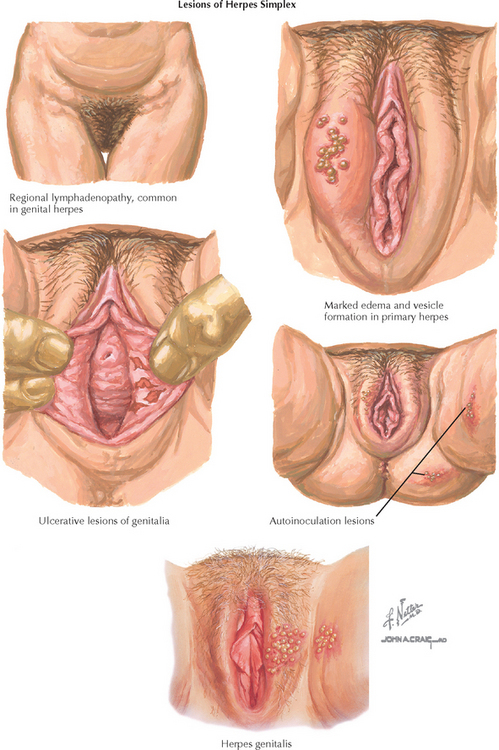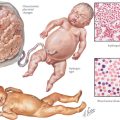Chapter 50 Sexually Transmitted Infections: Herpes
INTRODUCTION
ETIOLOGY AND PATHOGENESIS
CLINICAL CHARACTERISTICS
Signs and Symptoms
DIAGNOSTIC APPROACH
Workup and Evaluation
MANAGEMENT AND THERAPY
Nonpharmacologic
Drug(s) of Choice
FOLLOW-UP
MISCELLANEOUS
Aoki FY, Tyring S, Diaz-Mitoma F, et al. Single-day patient initiated famciclovir therapy for recurrent genital herpes: a randomized, double-blind, placebo-controlled trial. Clin Infect Dis. 2006;42:8.
Sheffield JS, Hill JB, Hollier LM, et al. Valacyclovir prophylaxis to prevent recurrent herpes at delivery: a randomized clinical trial. Obstet Gynecol. 2006;108:141.
Watts DH, Brown ZA, Money D, et al. A double-blind, randomized, placebo-controlled trial of acyclovir in late pregnancy for the reduction of herpes simplex virus shedding and cesarean delivery. Am J Obstet Gynecol. 2003;188:836.
Andrews WW, Kimberlin DF, Whitley R, et al. Valacyclovir therapy to reduce recurrent genital herpes in pregnant women. Am J Obstet Gynecol. 2006;194:774.
Benedetti JK, Corey L, Ashley R. Recurrence rates in genital herpes after symptomatic first-episode infection. Ann Intern Med. 1994;121:847.
Bryson Y, Dillon M, Bernstein DI, et al. Risk of acquisition of genital herpes simplex virus type 2 in sex partners of persons with genital herpes: a prospective couple study. J Infect Dis. 1993;167:942.
Cone RW, Swenson PD, Hobson AC, et al. Herpes simplex virus detection from genital lesions: a comparative study using antigen detection (HerpChek) and culture. J Clin Microbiol. 1993;31:1774.
Corey L, Wald A, Patel R, et al. Once-daily valacyclovir to reduce the risk of transmission of genital herpes. N Engl J Med. 2004;350:11.
Eckert LO, Lentz GM. Infections of the lower genital tract. In: Katz VL, Lentz GM, Lobo RA, Gershenson DM, editors. Comprehensive Gynecology. 5th ed. Philadelphia: Mosby/Elsevier; 2007:578.
Gottlieb SL, Douglas JMJr, Foster M, et al. Incidence of herpes simplex virus type 2 infection in 5 sexually transmitted disease (STD) clinics and the effect of HIV/STD risk-reduction counseling. J Infect Dis. 2004;190:1059.
Gupta R, Wald A, Krantz E, et al. Valacyclovir and acyclovir for suppression of shedding of herpes simplex virus in the genital tract. J Infect Dis. 2004;190:1374. Epub 2004 Sep 20
Nagot N, Ouedraogo A, Foulongne V, et alANRS 1285 Study Group. Reduction of HIV-1 RNA levels with therapy to suppress herpes simplex virus. N Engl J Med. 2007;356:790.
Oxman MN, Levin MJ, Johnson GR, et alShingles Prevention Study Group. A vaccine to prevent herpes zoster and postherpetic neuralgia in older adults. N Engl J Med. 2005;352:2271.
Roberts CM, Pfister JR, Spear SJ. Increasing proportion of herpes simplex virus type 1 as a cause of genital herpes infection in college students. Sex Transmit Dis. 2003;30:801.
Scott LL, Hollier LM, McIntire D, et al. Acyclovir suppression to prevent recurrent genital herpes at delivery. Infect Dis Obstet Gynecol. 2002;10:71.
Sheffield JS, Hollier LM, Hill JB, et al. Acyclovir prophylaxis to prevent herpes simplex virus recurrence at delivery: a systematic review. Obstet Gynecol. 2003;102:1396.
Stone KM, Reiff-Eldridge R, White AD, et al. Pregnancy outcomes following systemic prenatal acyclovir exposure: conclusions from the International Acyclovir Pregnancy Registry, 1984–1999. Birth Defects Research (Part A). 2004;70:201.
American College of Obstetricians and Gynecologists. Gynecologic herpes simplex virus infections. ACOG Practice Bulletin 57. Washington, DC: ACOG, 2004.
American College of Obstetricians and Gynecologists. Sexually transmitted diseases in adolescents. ACOG Committee Opinion 301. Washington, DC: ACOG, 2004.
Centers for Disease Control and Prevention. Sexually transmitted diseases treatment guidelines, 2006. MMWR. 2006;55:16.
Engelberg R, Carrell D, Krantz E, et al. Natural history of genital herpes simplex virus type 1 infection. Sex Transmit Dis. 2003;30:174.
Sen P, Barton SE. Genital herpes and its management. BMJ. 2007;334:1048.
Tita AT, Grobman WA, Rouse DJ. Antenatal herpes serologic screening: an appraisal of the evidence. Obstet Gynecol. 2006;108:1247.








